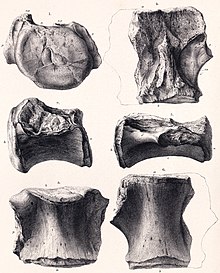Bothriospondylus
| Bothriospondylus | |
|---|---|

| |
| Illustration of the holotype vertebrae of B. suffosus | |
| Scientific classification | |
| Domain: | Eukaryota |
| Kingdom: | Animalia |
| Phylum: | Chordata |
| Clade: | Dinosauria |
| Clade: | Saurischia |
| Clade: | †Sauropodomorpha |
| Clade: | †Sauropoda |
| Clade: | †Neosauropoda (?) |
| Genus: | †Bothriospondylus Owen, 1875 |
| Species: | †B. suffossus
|
| Binomial name | |
| †Bothriospondylus suffossus Owen, 1875
| |
| Synonyms | |
| |
Bothriospondylus ("excavated
Discovery and naming
The type species, Bothriospondylus suffossus, was described by Richard Owen in 1875.[1] The specific epithet suffossus means "undermined" in Latin, a reference to the fact that pleurocoels had hollowed out the sides of the vertebra. It is often incorrectly spelled as "suffosus". Owen based the species on holotype NHMUK R.44592-5, a set of four dorsal vertebrae found in Wiltshire in stratum from the Kimmeridgian, the Kimmeridge Clay. Also three unfused sacral vertebrae were referred.

At the same time Owen named three other species of Bothriospondylus. B. robustus was based on NHMUK R.22428, a dorsal from the same location. B. elongatus was based on a vertebra from
More complete material from
In 1986 José Fernando Bonaparte moved material from "B." sp. into its own genus,
A revision in 2010 by
Classification
Bothriospondylus has over the years been assigned to many groups — even in a Bothriospondylidae of its own
Current species

Only the type species of Bothriospondylus can be referred, because of the dubious nature of the genus.[6]
- Bothriospondylus suffossus Owen, 1875 (type species) = Ornithopsis suffosa (Owen, 1875) von Huene, 1922
Reassigned species
Several species have been referred to Bothriospondylus over its existence, with nearly all being reassigned to a new genus.
- Bothriospondylus robustus Owen, 1875 renamed Marmarospondylus (Owen, 1875) Owen, 1875[1]
- Bothriospondylus elongatus Owen, 1875 non Bothriospondylus[6]
- Ornithopsis hulkei Seeley, 1870[6]
- "Bothriospondylus madagascariensis" Lydekker, 1895 removed from species and named Lapparentosaurus Bonaparte, 1986[5]
- "Bothriospondylus" Lydekker, 1895 [6]
- "Bothriospondylus" madagascariensis Lydekker, 1895 NHM R2598 NHM R2596–2615, R16588, R16589
References
- ^ .
- ^ S2CID 128431891.
- ^ de Lapparent, A.F. (1943). "Les dinosauriens jurassiques de Damparis (Jura)". Mémoires de la Société Géologique de France. 47: 5–20.
- PMID 28480136.
- ^ a b Bonaparte, J.F. (1986). "Les dinosaures (Carnosaures, Allosauridés, Sauropodes, Cétosauridés) du Jurassique Moyen de Cerro Cóndor (Chubut, Argentina)". Annales de Paléontologie (Vert.-Invert.). 72 (3): 325–386.
- ^ .
- ^ .
Further reading
- Nopcsa, F. 1902. Notizen uber Cretacischen Dinosaurier. Pt. 3. Wirbel eines sudamerikanischen Sauropoden. Akademie der Wissenschaften, 3, 108–114.
- Thevenin, A. 1907. Pale´ontologie de Madagascar. Annales de Pale´ontologie, 2, 121–136.
- Thulborn, R. A. 1973. Teeth of ornithischian dinosaurs from the Upper Jurassic of Portugal. Memo´ria dos Servic¸os Geolo´gicos de Portugal (Nuova Se´ria), 22, 89–134.
